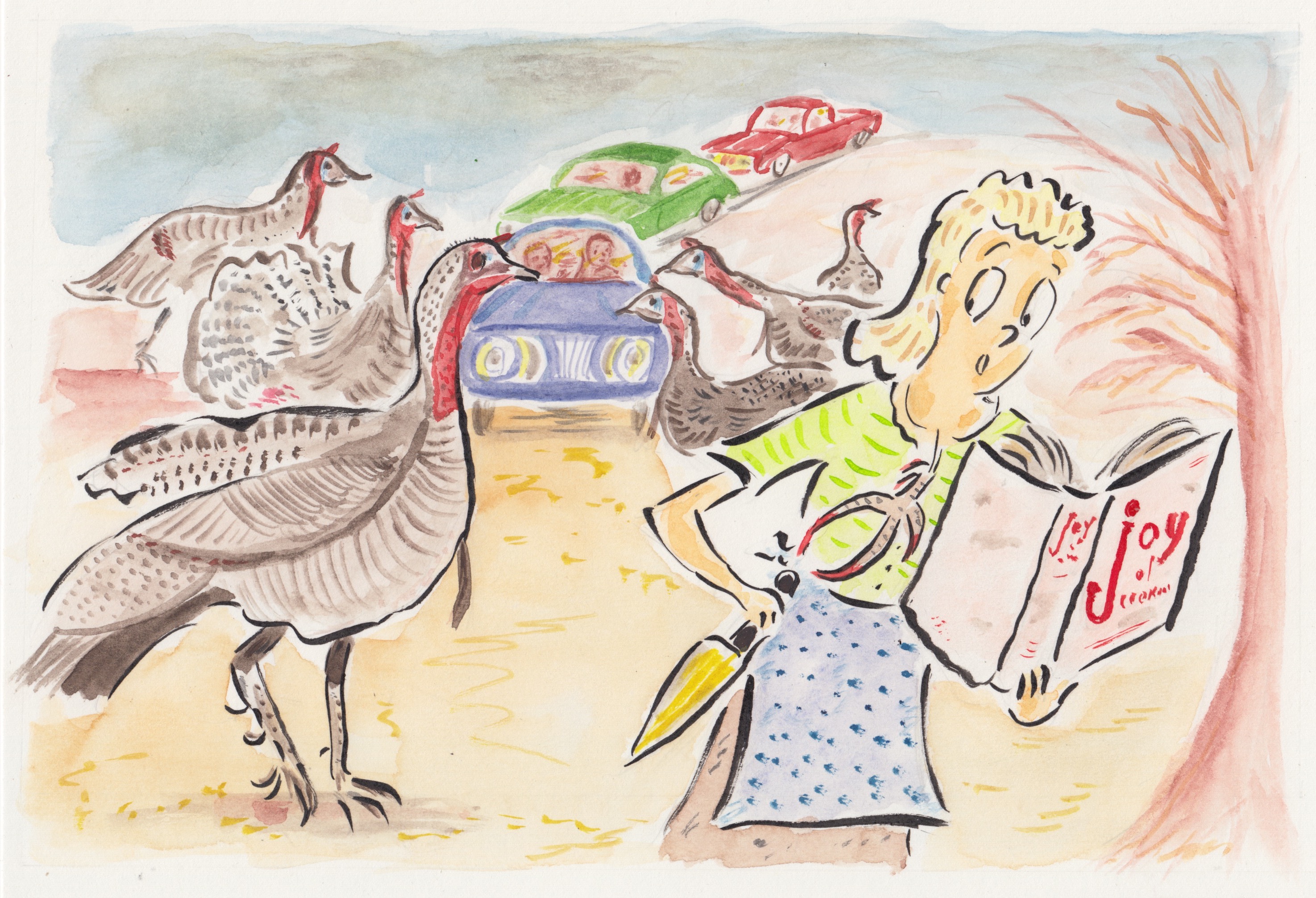Shortly after we moved to the Island in 1974 a friend told us about a farmer who would sell us one of his homegrown turkeys. I can't remember who the farmer was, but a day or two ahead of Thanksgiving he drove his truck into our driveway and unloaded a big sack of a bird, about 23 pounds worth as I recall.
After being chagrined by its size and heft, we noticed that the bird still had its feet attached. At least his head was gone and I didn't need tweezers for its pinfeathers. I can't remember how we removed these unsightly feet from our holiday centerpiece, probably with an axe and out of my sight, but I've since read the proper way to do it.
“Cut through the skin about 1-1/2 inches above the knee. Lay the fowl on its back with the cut in the skin just at the edge of the table and the rest of the leg projecting beyond it. Press the foot and ankle down sharply to snap the bone at the knee joint. Pull steadily,” advises the classic bestseller, Irma Rombauer's Joy of Cooking.
West Tisbury's wild turkeys have been known to fly up onto our roof and perform a little tapdance on a skylight, providing a worm's eye view of those feet. At ground level, you can see their tracks in the early dustings of snow or a skim of mud. You won't confuse turkey tracks with paw prints.
The fowl we bought that day was plump and sleek but its feet would never be Cinderella-worthy. They were so gnarly and knotty, a size-four narrow, with toenails elegantly contoured, just begging for a coat of fire-engine red nail polish. We put the feet aside for another day, and a few months later painted the talons of one foot and strung it from a leather shoestring to make a bespoke necklace for a dear friend's birthday — the same friend who had recommended the Island-grown bird in the first place. She bravely wore the primitive bijou at her birthday party but it hasn't been seen since. Nobody knows what happened to the second foot either.
A decade earlier, when I decided to roast my first turkey, I turned to my original version of Joy of Cooking, which told you everything. It was probably an early 1960’s edition. It wore out. My current, well-used, broken-backed copy is its 43rd printing, dated 1987. The recipe I used back then, entitled Roast Turkey, began with the instruction, “Draw, singe and truss a turkey.” I hadn't done much cooking yet, and I was stymied. My mother never drew or singed her poultry and never would.
In another part of Joy of Cooking, Mrs. Rombauer concedes that turkeys are usually plucked and drawn when you buy them. But she describes how to do it, just in case, using tweezers or the melted paraffin method, which one hopes will never be necessary. She then tells us how to singe the last of the pinfeathers over a gas flame or a candle. Again, how hippie/primitive do you want to be?
Back in question these days is whether to brine or not brine. Brining requires a bit of kitchening a day or two before the holiday, but I believe a good soak adds a touch of flavor and assures that the bird will be juicy and tender, never dry. The following recipe is in my handwriting, no credit to the author, so I apologize if it came from you, dear reader, but it's worth sharing:
Turkey Brine
A day or two before roasting, bring 4 cups water to a boil. Add 1 cup kosher salt and 1 ½ cups sugar; stir until dissolved. Add 8 more cups of water, 2 cups cider vinegar, 2 tablespoons dried sage, 2 tablespoons dried thyme, and 2 tablespoons dried rosemary. Remove the giblets and neck from the turkey. Rinse and dry the turkey inside and out. Submerge the bird in the brine (I use a lobster pot) face down, as if it had a face. Flip it halfway through the session, which should last 24 hours or so. Do not use a self-basting turkey. Find a very cold spot to hold the turkey during those 24 hours (Specifically, a spot that does not go up over 40 degrees, my editor tells me…].
Eileen’s All–in-One Turkey Soup
And here’s my favorite recipe for leftovers. The V8 juice is a tip from my late mother-in-law. It cuts the strong turkeyness from the flavor. You'll appreciate it. The Valencia orange peel is a secret ingredient from a friend who is a fine cook. It's on the spice shelf at Cronig's, and elsewhere. The friend always adds a pinch to the soups and stews and casseroles he serves and now I do too. It's a blessing.
Makes: A lot
When you're done picking at the turkey, take it apart so it all fits it in a big soup pot. Add 2 boxes of chicken broth (64 ounces) and simmer for several hours. It doesn't need attending. Once the pieces fall apart, pick out the bones, the skin, and the unattractive bits that you don't want to eat. Cut the meat into bite-size pieces and return the meat to the broth, along with about 1 large onion, chopped; 1 clove garlic, minced; 3 stalks celery, chopped; ½ cup rice (any kind); 5 carrots, peeled and cut in chunks; 2 cups green beans, trimmed and cut in half; 16 ounces of V8 juice; 1 teaspoon poultry seasoning; a bay leaf, and ¼ teaspoon Valencia orange peel. If you like (we do), add in leftover gravy and stuffing as well. (It makes a very hearty meal!) Simmer for an hour.
Editor's Note: If for some reason you are in possession of the turkey's feet, don't throw them away! Add them to the broth for this soup; they add collagen and calcium!
Eileen Maley lives in West TIsbury.







